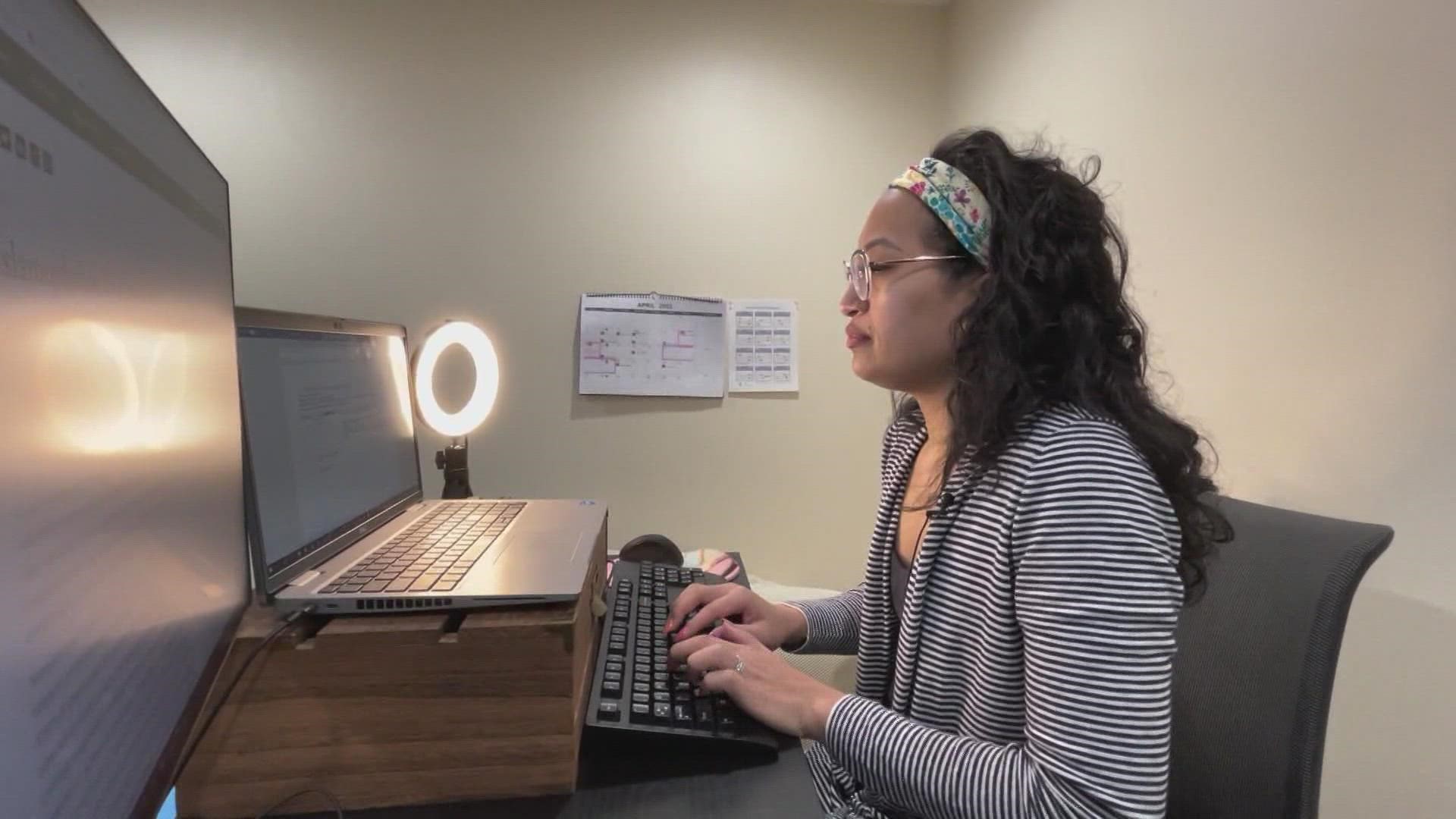Western Washington moms share experiences balancing work and family life
A KING 5 special series focuses on working moms and the everyday challenges which have led to a higher likelihood of burnout because of the COVID-19 pandemic.

A recent study of hundreds of thousands of working parents revealed working moms are 28% more likely to experience burnout than working dads.
Maven Clinic, a virtual clinic for women and family health, conducted a series of two studies during the COVID-19 pandemic hearing directly from more than 440,000 working parents in one round and more than 490,000 in the second round.
Along with Great Place to Work, Maven reported the main reasons for potential burnout included moms feeling a lack of support when returning to work from maternity leave, struggles to find affordable and reliable child care and a lack of mental health resources. Working moms cited the pandemic as something that exacerbated those challenges.
KING 5 spoke to several western Washington working moms on and off camera about the challenges they are facing and what they are doing to make positive changes. Topics include the gender pay gap, child care, mental health and becoming an entrepreneur.
During this special KING 5 series, two working moms in western Washington shared their journeys in coping with anxiety and depression. Click here for more resources if you or a mom you know needs help identifying signs of depression.
Gender pay gap
According to the U.S. Bureau of Labor Statistics, women working full time are still paid 83 cents for every dollar men earn. The gap is even bigger for working moms.
Mothers earn only 71 cents for every dollar paid to fathers, according to the American Association of University Women (AAUW). The gap in pay translates to a loss of $16,000 annually.
To close the gap, the AAUW said there needs to be strong state and federal laws focused on ensuring equal pay for all American women.
The group supports legislation and the protection against workplace discrimination, such as the Pregnant Workers Fairness Act.
During the pandemic, some industries were impacted more than others due to COVID-19 restrictions and business closures.
Paying rent became a struggle for those who were furloughed or lost their jobs, and many municipalities enforced eviction moratoriums, including the city of Seattle. This caused people like single mom Stephanie Lawson to lose their job in building management.
"I haven't looked for a job in over a decade," said Lawson. “So, I was like, what do I do?"
Lawson said she relied heavily on her years of experience and qualifications. It only took a few weeks to find a new job in the same field, but it came with an hour-long commute from Kent to Bellevue.
During the job search, Lawson discovered disturbing realities.
"The sad part was when you see the pay scaling or asked about pay scale, and you see it, you're like, how do I support myself? Like how do I support my children?" Lawson asked. "This pay could support a single person, maybe, but not your children."
Child care crisis
The COVID-19 pandemic forced child care centers to change health and safety protocols, and at times shut down due to COVID exposures or an outbreak.
According to a report from the Washington State Child Care Collaborative Task Force (CCCTF), the pandemic has revealed enormous disparities in access to affordable care, how inadequately we compensate and support our child care workforce, and the disproportionate burden that remains on women to fill an unpaid role of caring for children at home.
About 10 million U.S. mothers living with their school-age children were not actively working in January 2021, which is 1.4 million more than during Jan. 2020, according to new U.S. Census Bureau data.
Child care became one of the biggest barriers for mothers planning to return to work or stay in their current job, according to a national survey of hundreds of thousands of working parents.
“I think we called like four or five daycares and we were on a waiting list," said Tessa Kerley, a Buckley mom of two who is an elementary school teacher in Kent.
The Kerleys went on the hunt for new child care after they recently moved to Buckley, leaving behind an at-home child care setup.
Kerley told KING 5 that she and her husband regularly discussed if one of them should quit their job or go part-time to stay home with their kids and avoid child care altogether. Thanks to a co-worker's recommendation, the Kerleys finally found day care for one of their children while the other goes to school where Kerley teaches.
"Just the cost of everything really, you know, we really rely on the dual-income," said Kerley.
Kerley's son 3-year-old son, Rhett, has asthma, which causes him to cough a lot. In turn, it complicates his entry into day care.
"You have to sign every morning that they don't have a fever; they don't have a cough; they don't have a runny nose,” explained Kerley.
The CCCTF report shows providers keep wages low to cover costs. The average child care employee in Washington state makes less than $15 an hour, which is the lowest earnings of any college major. The industry's turnover rate is 43%.
The task force recommended the state change how child care is financed, saying a change would make it affordable for all families, and providers could stay in business with a workforce that is paid fairly.
Kerley said it would be a positive move for more employers to offer support when it comes to child care, whether it's through providing it or making referrals.
“Not only just because it takes that pressure off, but it also shows the support that the employer has for working moms," said Kerley.
The number of businesses providing child care solutions on-site or through referrals is small, but they cite child care offerings as a priority to attract or retain workers.
Kerley stands by her recommendation to other working moms in asking for referrals in Facebook mom’s groups and through co-workers.
Resources are available through various agencies in Washington state, including Working Connections Child Care (WCCC).
WCCC helps eligible families pay for child care when a family qualifies for child care subsidy benefits and chooses an eligible provider.
In this case, the state pays a portion of the cost of child care. Parents may be responsible for a copayment to their provider each month. Click here for more information.
Mental health journeys
Kelci Berto is a nurse in Renton and a mom of two.
While she’s been in health care for 15 years, she said the COVID-19 pandemic piled on pressure and stress she did not know was possible.
“I was really suffering from burnout from the pandemic, working in the hospital, and trying to balance all that with being a mom,” said Berto.
The lack of PPE at the beginning of the pandemic and changing protocols added to the stress of an already demanding schedule. Berto said she felt a disconnect from her role as a mom.
“I didn't know what they were doing in school, I didn't know what they were learning,” said Berto. “I didn't see them as much as I wanted to.”
In January, Berto said a day meant to be a family day turned dark as she confronted a mental health crisis. She hit a breaking point and later learned she was “passively suicidal.”
“I wished I was dead, or that something would happen and I would die, but that I wouldn't have to be the one to do it,” explained Berto.
Taking time off from work using family leave was recommended as a “must” by Berto’s therapist.
Berto recently returned to work and continues therapy. She said her husband of 17 years and her two children are her “loving lifeline.” She wants other working moms to know they are not alone and that positive changes can be made to improve mental health.
Berto is in the process of reassessing her work schedule at the hospital and considering switching jobs while remaining in health care.
“I kept thinking, I can hold it together… and I forced myself to do that for a long time until I finally broke,” said Berto. “I would tell other moms, don't wait until you break.”
With similar advice, Rassamy Smith, a Kent mom of two, said she also waited until she hit a breaking point to make changes in her life.
“I was drained every morning and I realized, like when I was sitting in the parking lot where I just didn't want to come into work,” Smith said about her elementary school teaching job.
After 10 years of working as a teacher, Smith said a change was needed as she attended regular therapy.
Currently, Smith is an instructional educational designer and works from home. She said the new flexible schedule helps her make more time for her children and herself.
Along with learned coping tools for anxiety and depression, Smith said swing dancing has been a “go-to” for her mental health.
“That really, really has lended into supporting my mental health where I get to feel and thrive in my individuality,” said Smith.
Her husband and children are supportive of her mental health focus, which Smith said has been crucial.
As the daughter of immigrants from Laos, Smith said talking about mental health or “being too emotional” was not talked about in her culture or within her family – until now.
Smith’s new position also offers a wide range of mental health care options and she said her employer encourages her and all employees to take advantage of those services.
According to Maven Clinic and Great Place to Work research, the pandemic’s impact on working moms’ emotional and mental health is equally alarming and disproportionate, with an estimated 2.4 million additional cases of burnout among this group due to unequal demands of home and work.
If you or someone you know needs support in a suicidal crisis or emotional distress, call 800-273-8255 to reach the National Suicide Prevention Lifeline. It’s a 24-7 lifeline.
Dr. Sheryl Ziegler, a psychologist and author of “Mommy Burnout,” told CNBC burnout is a “pretty serious condition.”
Ziegler said it can appear in both physical and emotional symptoms. The most common signs include fatigue, lack of motivation, nausea, hair loss, headaches, chest tightness and increased crying. For many, it manifests in both emotional and physical symptoms.
Research hospital, University of California, Irvine Medical Center, shared information on recognizing and coping with “mommy burnout.”
Coping recommendations:
- Be honest and talk it out with people you trust
- Ask for help
- Create routines
- Schedule "me" time
- Set boundaries. Learn to say no or find alternatives
- Monotask instead of multitasking
- Lower expectations
Becoming a "mompreneur"
“I've got people relying on me at work, and I need to put my kids first,” said Lacey Jones, a Kent mom of five.
Jones recently launched her own business, a life coaching practice based out of her family’s home.
During the peak of the COVID-19 pandemic, Jones found herself juggling a demanding sales job and trying to “be present” for her five boys trying to learn from home.
“Right now, it's regaining their sanity, right?” said Jones. “A lot of the stems, I think, from the pandemic and from having to pull kids in and out of school.”
Jones said her previous job paid six figures, but the struggle to balance work and family was not worth the paycheck.
Jones began working on her life coaching certification more than a year ago. She completed the course work a few months ago and made the change to “mompreneur” soon after.
Jones is one of millions of people across the country who decided to resign and start their own business.
According to the U.S. Labor Department, 4.4 million worker resignations were recorded last fall, and the number of unincorporated self-employed workers is up by 500,000 since the start of the pandemic.
A 2021 study by the National Association of Women Business Owners and Gusto Company News found 58% of women wanted more flexibility and control over their work hours.
“I love it,” said Jones. “I feel like everything I've done over the last 20 years in my work experience has set me up for this.”
Her life experience as a wife and mother influenced her business mission of “raising confident moms” with healthy expectations.
“You can't do it all,” said Jones. “You can't. You can't be there for everyone.”
Jones said she avoided “working mom burnout” by becoming a mompreneur and said her new career goal as a life coach is to help other moms find their balance.
“There's a lot going on in the world and there's hope out there,” said Jones. “There's hope for you as a mom and whatever struggle you're going through.”
Women entrepreneur support organizations:
"What we love most"
Five western Washington moms shared what they love most about being a working mom:
"I'm proud of myself and I'm proud that I can show my kids that no matter how hard it is, you can still do this." - Stephanie Lawson, mom of two boys, Bellevue property manager.


"I can show my kids what it's like to have dreams and get after them. To accomplish things to learn to develop my skills, my talents and not just be at a standstill in my life, but to show them progress." - Lacey Jones, mom of five boys, Kent life coaching business owner.


"I can contribute to the community and the health of the community, while also setting an example for my kids... that they can do whatever they want when they grow up and that I will be there to support them." - Kelci Berto, a Renton nurse and mom of two.


"I get to show my family and especially my children that you can have a career and have a family at the same time and have the life that you that you want to live." - Rassamy Smith, mom with one son and daughter, Kent instructional designer for learning and development.


"I get to have the best of both worlds, especially as a teacher. I love being with my kids and enjoying watching them grow, but I also love going to a job where I can still have an identity of me. Being a teacher is a rewarding job and has been my passion since I was young. I feel fortunate that I am able to still follow my dreams & show my kids what hard work is, it is something I am proud of." - Tessa Kerley, mom with one son and daughter, teaches in Pierce County.




